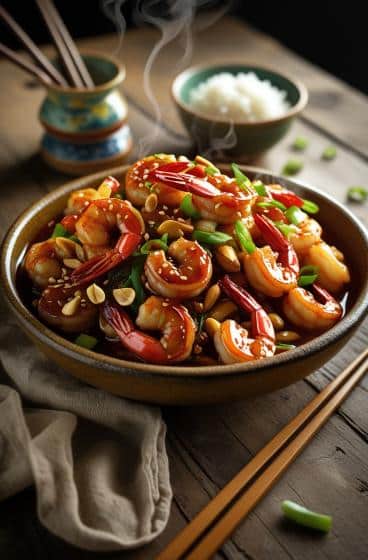Ever stood over a sizzling wok and felt the steam slap your face while chili peppers dance around in hot oil? Few kitchen moments feel more alive. I still remember the first time I tried my hand at Kung Pao Shrimp, and nearly jumped back when the dried chilies burst open in a quick, smoky flare. This dish isn’t just a recipe. It’s a brief, spicy drama played out in minutes, right there in your kitchen. And mate, it’s worth every second.
Kung Pao Shrimp hails from Sichuan cuisine, loved for its tingling heat, sweet-savory glaze, and that crunch of roasted peanuts. Unlike the heavier American take-out versions swimming in sticky sauce, the classic approach is lighter, fiery, and complex with layers of umami from soy, Shaoxing wine, and black vinegar. And yes, it’s special not just because it tastes cracking good—but because it celebrates balance: heat, sweet, tang, and crunch. Let’s dive into what makes this classic roar to life.
Ingredients & Substitutions
A dish this quick to cook leaves you nowhere to hide, so ingredients matter. But life ain’t always perfect—so here’s how you can dance around when needed.
| Ingredient | Purpose | Substitutions / Notes |
|---|---|---|
| Medium to large raw shrimp (peeled, deveined) | Star of the dish | Can use scallops or cubed firm tofu for pescatarian or vegetarian |
| Dried red chilies | Signature heat | Use chili flakes in a pinch, though you’ll miss the smoky bursts |
| Sichuan peppercorns | Adds mouth-tingling effect | Substitute with black pepper, though it won’t quite tingle |
| Roasted peanuts | Crunch & nutty sweetness | Cashews work, or sunflower seeds for nut allergies |
| Garlic & ginger | Fragrance & depth | Always fresh, not powdered |
| Scallions | Color & fresh bite | Chives or leeks if you must |
| Soy sauce | Savory umami | Tamari or coconut aminos if gluten-free |
| Shaoxing wine | Sweetness & depth | Dry sherry or mirin |
| Chinese black vinegar | Tangy sharpness | Balsamic vinegar, sparingly |
| Sugar | Balances heat | Honey or maple syrup |
| Cornstarch slurry | Thickens sauce | Arrowroot powder works too |
| Sesame oil | Aroma & gloss | Leave out if allergic, but you’ll miss the fragrance |
When picking shrimp, go fresh if you can. Frozen is okay, just thaw gently in cold water—not in the microwave. And always dry them well; wet shrimp won’t caramelize properly. As for Sichuan peppercorns, toast them lightly until fragrant before using—raw, they taste oddly woody.
Step-by-Step Instructions
Alright, apron on. Wok or deep skillet ready. High heat is your friend here, but control is king.
1. Prep everything first
No kidding—this dish cooks in minutes. Have the shrimp patted dry, sauce mixed in a small bowl, peanuts roasted and measured, chilies snipped into halves, and scallions chopped.
2. Heat oil & fry aromatics
In a wok over medium-high heat, swirl a couple tablespoons of neutral oil. Add dried chilies and Sichuan peppercorns. Fry until the chilies darken slightly—not burn. This releases the smoky, floral kick. Common mistake? Walking away here. Stay put; 10 seconds too long and your whole kitchen smells like burnt toast.
3. Toss in garlic & ginger
Quick stir. You should smell heaven right about now.
4. Shrimp goes in
Crank heat to high. Spread shrimp around the pan so each piece kisses the heat. Let them sear 30 seconds before stirring. Move fast but don’t overcook—shrimp turns rubbery quick.
5. Sauce & nuts
Pour in sauce and stir until it thickens and coats the shrimp. Add peanuts, toss a few times. Sauce should cling, not pool. If it feels dry, splash a tablespoon of water.
6. Finish & plate
Off heat, drizzle sesame oil and toss in scallions. Serve hot over steamed rice.
Variations? Love spicy? Add chili oil to the sauce. Crave sweetness? Stir in pineapple chunks before adding peanuts. Going vegetarian? Use crispy fried tofu cubes instead of shrimp.
Cooking Techniques & Science
Why fry chilies and peppercorns first? That hot oil extracts fat-soluble flavors, so every bite carries the heat and tingle. Toasting peppercorns wakes up the numbing compound—hydroxy-α-sanshool (bit of food nerd stuff).
Stir-frying shrimp over high heat caramelizes natural sugars on the surface, giving subtle sweetness. And cornstarch slurry thickens sauce by gelatinizing starch granules when heated, so it coats every bite.
Tools that help?
- Carbon steel wok: heats fast, keeps shrimp from steaming.
- Spider strainer: handy for lifting shrimp out if you want to drain extra oil.
- Small prep bowls: make you look like you’ve cooked on TV.
Storage & Reheating
Store leftovers in an airtight container, up to 2 days. Reheat quickly in a hot pan or microwave gently—overheating toughens shrimp. Best eaten fresh though, really.
More Substitutions
- Gluten-free? Use tamari instead of soy.
- Nut-free? Toasted pumpkin seeds bring crunch.
- Vegan? Crispy tofu, jackfruit, or king oyster mushrooms work beautifully.
Serving & Pairing Suggestions
Picture this: steaming bowl of jasmine rice, spooning glossy Kung Pao Shrimp over it, peanuts crackling between teeth.
Serve alongside:
- Stir-fried bok choy with garlic.
- Simple cucumber salad with rice vinegar.
- Cold sesame noodles if you’re feeling lavish.
Drink pairings? Dry Riesling cools the heat, oolong tea complements the spice, or a crisp lager refreshes the palate.
For presentation, scatter a few more roasted peanuts and raw scallion greens on top. The pop of green against the lacquered shrimp? Gorgeous.
Best time to serve or eat this dish
This dish shines at dinner, especially weeknights when you want something fast but deeply satisfying. But honestly, I’ve whipped it up at lunch and it brightened a dull workday. Serve it at gatherings too—it’s quick, impressive, and disappears fast.
Conclusion: Why this dish stays special
Kung Pao Shrimp isn’t just about shrimp tossed in sauce. It’s about playing with fire (literally and figuratively). You get contrast: crisp peanuts, tender shrimp, smoky chilies, fresh scallions. The sauce doesn’t drown the dish; it clings. And that balance? Sweet, salty, tangy, spicy—hard to beat.
Pro tips to keep in mind:
- Dry your shrimp well.
- Toast spices gently.
- Cook fast, don’t crowd the pan.
- Taste your sauce before adding—it’s easier to adjust then.
Try swapping nuts, adding pineapple, or making it vegan—you’ll discover new versions every time. Cooking is half technique, half curiosity, right?
FAQs
Q: Can I use frozen shrimp?
A: Yes! Thaw gently in cold water, dry thoroughly before cooking. Wet shrimp won’t brown nicely.
Q: It turned out too salty—why?
A: Some soy sauces are saltier. Start with low-sodium soy or use less, and always taste sauce before adding to pan.
Q: Can I prep ahead?
A: Absolutely. Mix sauce, chop aromatics, and dry shrimp earlier. Stir-fry only when ready to serve—it keeps shrimp tender.
Q: What if I can’t find Sichuan peppercorns?
A: Use black pepper for heat, but you’ll miss the numbing effect. Or buy them online—they’re worth it!
Q: Is this dish very spicy?
A: It can be, but you control it. Remove chili seeds for less heat, or add chili oil if you love it fiery.
That’s the beauty of Kung Pao Shrimp: fast, fiery, and flexible. And every sizzle in that wok is a small, tasty triumph. So go on—light that burner and let it dance.

